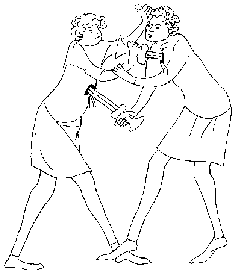Meet the Middle Ages
BackCrime and punishment

All through history, people have tried to stop crime. In the Middle Ages, people mainly tried to solve conflicts between two people. Today’s punishments concentrate more on revenge.
The most common crimes in the medieval towns were fights and thefts. Sometimes, there were brutal assaults or murders. Crimes, such as rape and economic crimes - like frauds and swindle, existed in the Middle Ages, but are more common today.
The Town Council also served as a law-court and when it did, it was called "rådstugurätten". The task of the Court was to solve a conflict between two parties; a person who was accused of doing wrong and another who had been affected by that wrongdoing. The aim of the punishment was to make the accused make up to those they had harmed. The most common punishment was a fine. When the fine was paid, the crime was forgiven and everything went back to normal in town. The aim of the punishment was also to avoid revenge.
However, if a person committed crimes repeatedly, or committed really severe crimes, the punishments were very hard indeed. A thief could lose a few fingers; a murderer could be sentenced to death.
Theft was severely punished in the Middle Ages. A thief had to pay heavy fines and could be sentenced to death. Sometimes a person who was sentenced to death was executed, but usually the sentence was whipping or fines. There were no prison sentences.
Sometimes it was considered punishment enough to have the criminal publicly humiliated. The Court could sentence the criminal to be put in the stocks or be pilloried in the market-place of the town. It could certainly be worse for some people to be put in the stocks than to pay a fine.